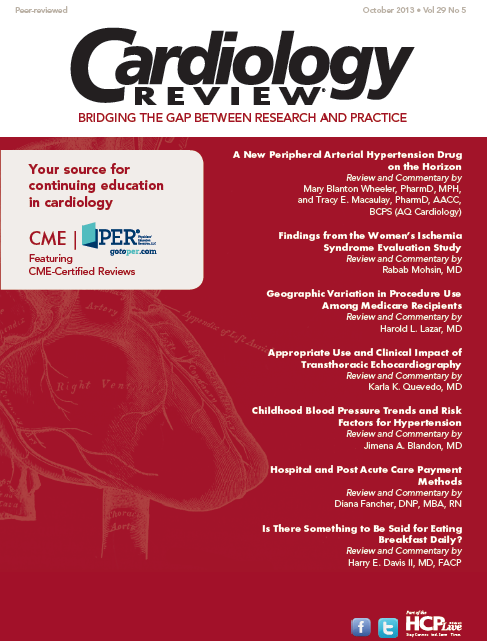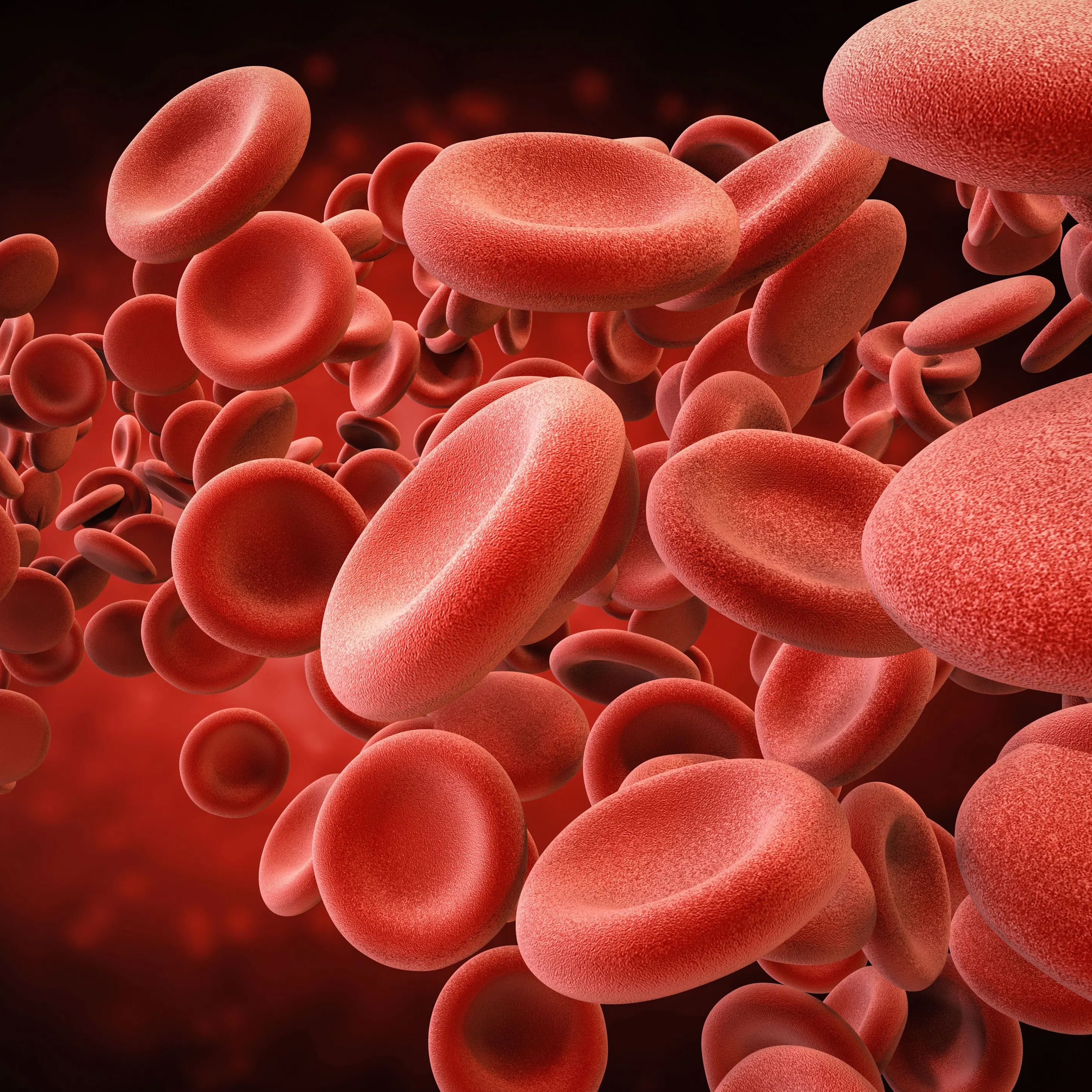Publication
Article
Cardiology Review® Online
Meeting Report: European Society of Cardiology (ESC) 2013 Congress
A review of the ACCOAST, ASSURE, Edoxaban Hokusai-VTE, EXAMINE, PRAMI, RE-ALIGN, and SAVOR-TIMI 53, and TAO studies presented at the European Society of Cardiology 2013 Congress.
European Society of Cardiology (ESC) 2013 Congress
Amsterdam, the Netherlands
Each year, the ESC Congress is the largest cardiology congress in Europe, with over 30,000 health care professionals in attendance from more than 150 countries. This year’s Congress, held in Amsterdam, the Netherlands, August 31-September 4, 2013, featured over 4200 abstracts presented in over 430 sessions. This year’s theme was “the heart interacting with systemic organs,” and included the following studies: ACCOAST, ASSURE, Edoxaban Hokusai-VTE, EXAMINE, PRAMI, RE-ALIGN, and SAVOR-TIMI 53, and TAO.
ACCOAST: No Benefit in Prasugrel Pretreatment of NSTE-ACS Patients at Diagnosis
Pretreatment of patients with non-ST-segment-elevation acute coronary syndrome (NSTE-ACS) with prasugrel at the time of diagnosis, rather than post angioplasty, does not improve ischemic events but it does result in more major bleeding complications. Gilles Montalescot, MD, PhD, of Pitié-Saltpêtrière University Hospital, Paris, presented these results from the ACCOAST trial, which are also published in The New England Journal of Medicine.1
ACCOAST had been designed to randomize 4,100 patients to an early or standard strategy, with placebo pretreatment given in the standard group. After enrollment of 4,033 patients, how-ever, the trial stopped enrollment after data showed an increase in major and life-threatening bleeding and no reduction in the cardiovascular (CV) events.
There was no significant difference between the 2 treatment groups at 7 or 30 days with respect to the primary efficacy end point (composite of CV death, myocardial infarction, stroke, urgent revascularization, or glycoprotein IIb/IIIa bailout). Thrombolysis In Myocardial Infarction (TIMI) major bleeding was significantly high in the pretreatment group at both points in time, as were the rates of non-coronary artery bypass grafting (CABG) TIMI major bleeding and life-threatening bleeding.
The study authors concluded that among patients with NSTE-ACS scheduled to undergo catheterization, pretreatment with prasugrel did not reduce the rate of major ischemic events up to 30 days but increased the rate of major bleeding complications.
References
1. Montalescot G, Bolognese L, Dudek D, et al. Pretreatment with prasugrel in non-ST-segment elevation acute coronary syndromes. N Engl J Med. 2013;369:999-1010.
ASSURE: Keep Looking for Agent that Raises HDL
The experimental apolipoprotein A1 (apoA1) inducer RVX-208 failed to show efficacy in increasing high-density lipoprotein (HDL) cholesterol and reducing arterial plaque in the ApoA1 Synthesis Stimulation and Intravascular Ultrasound for Coronary Atheroma Regression Evaluation (ASSURE) study.
ASSURE was a prospective, randomized, double- blind clinical trials conducted at 60 centers, randomizing 323 patients with low HDL and coronary disease who had a target blood vessel for imaging with <50% stenosis. All patients received treatment with either atorvastatin 10 mg/d to 40 mg/d or rosuvastatin 5 mg/d to 20 mg/d, and were also randomized to receive either RVX-208 100 mg or placebo twice daily for 26 weeks.
The primary and secondary outcomes of the study were change from baseline in percentage of atheroma volume and normalized total atheroma.
Of the 281 patients who remained in the study and underwent imaging, there was no significant difference in efficacy outcomes between the groups. There was a trend toward plaque reduction in the RVX-208 group compared with baseline. There were more discontinuations due to adverse events in the RVX-280 group as well as significantly more elevations of liver enzymes at triple the normal limit or more.
The lack of efficacy of RVS-208 was surprising and disappointing, said lead researcher Stephen Nicholls, MBBS, PhD, Deputy Director of the South Australian Health and Medical Research Institute, Professor of Cardiology at the University of Adelaide, and Consultant Cardiologist at the Royal Adelaide Hospital in Adelaide, Australia. Earlier findings had been promising, he said. Dr Nicholls said the failure of RVX-208 to incrementally impact atherosclerotic plaque should not be taken as a failure of the hypothesis that increasing the level and activity of HDL could result in this benefit.
Hokusai-VTE Study: Once-Daily Edoxaban May Be as Effective as Warfarin for DVT
The once-daily oral factor Xa inhibitor edoxaban may be at least as effective as warfarin for the prevention of recurrences in patients with acute venous thromboembolism (VTE), while reducing the risk of some types of bleeding, say Hokusai-VTE study investigators.
Harry R. Buller, MD, of the Academic Medical Center in Amsterdam, chair of the study committee, said the trial had succeeded in enrolling patients across a broad spectrum of venous thromboembolic manifestations, ranging from limited proximal deep vein thrombosis to severe pulmonary embolism. Relative efficacy had been observed throughout the trial.
More than 8,200 patients were randomized to either edoxaban or warfarin, each after at least 5 days of open-label enoxaparin or unfractionated heparin. At 1 year, patients treated with edoxaban were noninferior versus the other group with respect to efficacy and superior for fatal and intracranial bleeding. A difference for major bleeding did not reach significance.
Patients were treated for at least 3 months but were evaluated at 12 months whether or not they remained on randomized therapy. The investigators said that the relative efficacy of edoxaban was not limited to patients receiving medication but was evident even among those who stopped treatment prior to 12 months.
Dr. Buller noted that the fact that patients were randomized after at least 5 days of open-label enoxaparin or unfractionated heparin meant that the trial actually enrolled very high-risk patients.
The study was published in The New England Journal of Medicine on September 1, 2013.1
The trial was funded by Daiichi-Sankyo. Dr. Buller discloses consulting for Bayer, Boehringer Ingelheim, Bristol-Myers Squibb, Isis Pharmaceuticals, and ThromboGenetics, and receiving support from Bayer and Pfizer.
References
1. The Hokusai-VTE Investigators. Edoxaban versus warfarin for the treatment of symptomatic venous thromboembolism. N Engl J Med. 2013. doi:10.1056/NEJMoa1306638.
EXAMINE, SAVOR-TIMI 53: DPP-4 Inhibitors Neither Increase nor Decrease CV Risk in Diabetic Patients
Two trials (EXAMINE and SAVOR-TIMI 53) presented at ESC 2013 found that the diabetes medications of the DPP-4 inhibitor class had a null effect on risk for fatal and nonfatal cardiac events. While these findings are a plus for doctors concerned that this class of antihyperglycemic drugs would increase the risk of heart attacks or strokes, the downside is that alogliptin and saxagliptin did not reduce the risk of cardiac events.
Both studies were published in The New England Journal of Medicine (NEJM).1,2
The EXAMINE STUDY recruited 5,380 type 2 diabetes mellitus (T2DM) patients within 3 months of hospitalization for acute myocardial infarction or unstable angina. The study found that compared with placebo, treatment with alogliptin for up to 40 months did not increase the risk of a second acute event.
The SAVOR-TIMI 53 study enrolled 16,492 T2DM patients with a history of cardiovascular disease (CVD) or considered to be at high risk for CVD. They were randomly assigned to either saxagliptin or placebo and followed for just over 2 years. The DPP-4 inhibitor neither increased nor decreased the risk of ischemic events; however, there was an increase in hospitalizations for heart failure.
SAVOR-TIMI 53 was funded by AstraZeneca and Bristol-Myers Squibb. EXAMINE was supported by Takeda Development Centers Americas.
References
1. White WB, Cannon CB, Heller SR, et al. Alogliptin after acute coronary syndrome in patients with type 2 diabetes. N Engl J Med. 2013;369:1327-1335. http://www.nejm.org/doi/full/10.1056/NEJMoa1305889.
2. Scirica BM, Bhatt DL, Braunwald E, et al. Saxagliptin and cardiovascular outcomes in patients with type 2 diabetes mellitus. N Engl J Med. 2013;369:1317-1326. http://www.ncbi .nlm.nih.gov/pubmed/23992601.
PRAMI: STEMI Patients Benefit from Preventive PCI of Nonculprit Lesions
In patients with acute ST-segment-elevation myocardial infarction (STEMI) who are undergoing percutaneous coronary intervention (PCI) of the infract artery, treatment of nonculprit lesions significantly reduces the risk of major adverse cardiovascular events (MACE), according to results of the Preventive Angioplasty in Acute Myocardial Infarction (PRAMI) trial. The study was stopped early based on a recommendation from safety monitoring committee data, which found a significant between-group difference in the primary end point favoring preventive PCI.
PRAMI investigators said a 65% relative reduction in the MACE risk was driven by a statistically significant reduction in the risk of nonfatal MI and refractory angina. There was also a trend toward a reduction in the risk of death from cardiac causes but the benefits did not reach statistical significance.
David Wald, MD, and colleagues from Queen Mary University of London reported that the trial showed that in patients with acute STEMI, using preventive PCI to treat noninfarct coronary artery stenosis immediately after PCI in the infarct artery provided a substantial advantage over not performing the added procedure. He said the benefit of preventive PCI over not treating culprit lesions occurred early and the full benefit was maximized after a few months.
Dr. Wald noted that the additional stents placed in nonculprit lesions added approximately 20 minutes to the procedure and increased the amount of radiation used.
As noted in an accompanying editorial by Lauri Mauri, MD, Harvard Clinical Research Institute, the strategy of treating nonculprit lesions differs from clinical practice; current guidelines recommend against treating multiple lesions during STEMI.
The study was published in The New England Journal of Medicine.1
References
1. Wald DS, Morris JK, Wald NJ, et al. Randomized trial of preventive angioplasty in myocardial infarction. N Engl J Med. 2013;369:1115-1123.
RE-ALIGN: Dabigatran Contraindicated in Patients with Mechanical Valves
Results from the Randomized, phase II study to Evaluate the safety and pharmacokinetics or oral dabiGatran etexilate in patients after heart valve replacement (RE-ALIGN) show that treatment with the oral anticoagulant resul- ted in a higher number of thromboembolic and bleeding events compared with warfarin treatment in patients with mechanical heart valve replacements.
Lead investigator Frans Van de Werf, MD, PhD, from the Department of Cardiovascular Sciences at University Hospitals, Leuven, Belgium, said the trial’s results do not support the use of dabigatran etexilate in patients with mechanical heart valves. The trial compared 252 patients who had undergone mechanical aortic and/or mitral valve replacements within 7 days after surgery and those who had received a mechanical mitral valve replacement at least 3 months earlier. Treatment with dabigatran etexilate for at least 12 weeks was compared with warfarin.
An interim analysis revealed a higher rate of strokes and major bleeding in patients on dabigatran (5.4% and 4.2%, respectively) compared with those on warfarin (0% and 2.4%).
In explaining why dabigatran is effective and safe in other indications, Dr Van de Werf said mechanical heart valves are clinically distinct from atrial fibrillation, for which dabigatran is approved. “Coagulation activation and thrombin generation seem to be partially induced by the exposure of blood to the artificial surfaces of the valve leaflets and sewing ring, whereas in atrial fibrillation, under low flood flow conditions, thrombin generation is believed to be triggered by blood stasis and endothelial dysfunction,” he said.
The study was published in The New England Journal of Medicine.1
The study was funded by Boehringer Ingelheim.
References
1. Eikelboom JW, Connolly SJ, Brueckmann M, et al. Dabigatran versus warfarin in patients with mechanical heart valves. N Engl J Med. 2013;369:1206-1214.
TAO: Increased Bleeding Creates Disappointing Results
Results of the Treatment of Acute Coronary Syndromes with Otamixaban (TAO) trial do not support the use of otamixaban for patients with non-ST-segment-elevation acute coronary syndrome (NSTE-ACS) undergoing planned early percutaneous coronary intervention (PCI). Otamixaban is a new intravenous direct factor Xa inhibitor. The TAO trial found that otamixaban did not reduce ischemic events compared with unfractionated heparin plus eptifibatide and a planned invasive strategy.
The development of the drug was discontinued after these results were first known, due to lower efficacy than expected. Lead investigator Gabriel Steg, MD, of the Hôpital Bichat in Paris, said the drug was the first intravenous factor Xa inhibitor to be studied in the acute setting, but the results suggest that these agents have an unfavorable efficacy/safety balance in the modern era of dual-antiplatelet therapy and routine intervention in ACS.
TAO was a double-blind superiority trial that enrolled 13,229 patients with NSTE-ACS and a planned early invasive strategy who were randomized to otamixaban or unfractionated heparin plus — at the time of PCI — eptifibatide. The dose used, 0.80 mg/kg bolus followed by an infusion of 0.140 mg/kg/h, was used. The primary efficacy outcome — composite of all-cause death or new myocardial infarction through day 7 — was not significantly different between groups. The primary safety outcome of TIMI major or minor bleeding through day 7 was, however, increased with otamixaban. Data on lower doses of otamixaban used in TAO did not suggest that a lower dose might have been better.
The investigators conclude that there is a narrow therapeutic window for acute Xa inhibition, and increasing the intensity of anticoagulation via this mechanism is unlikely to achieve a superior efficacy-safety balance in ACS.
The study was published in the Journal of the American Medical Association.1
References
1. Steg PG, Mehta SR, Pollack CV, et al. Anticoagulation with otamixaban and ischemic events in non-ST-segment elevation acute coronary syndrome: the TAO randomized clinical trial. JAMA. 2013;310:1145-1155.






